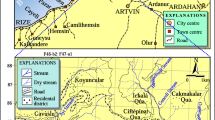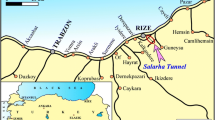Abstract
This paper presents the engineering geological properties and support design for a diversion tunnel through diabase at the Kapikaya dam site, eastern Turkey. The rock mass rating and rock mass index were used to determine the support requirements, which were also analyzed using commercial software based on the finite element method. The parameters calculated by the empirical methods were used as input parameters for the FEM analysis and the results from the two methods were compared. It was found that the optimum solution was obtained by using a combination of both empirical and numerical approaches.
Résumé
L’article présente les propriétés géotechniques des terrains et la conception d’un soutènement pour un tunnel de dérivation creusé dans des diabases sur le site du barrage de Kapikaya (Turquie de l’est). Les indices RMR et RMi ont été utilisés pour définir les renforcements nécessaires, utilisant par ailleurs des logiciels commerciaux basés sur la méthode des éléments finis (MEF). Les paramètres calculés par la méthode empirique ont été utilisés comme données d’entrée pour l’analyse MEF et les résultats des deux méthodes ont été comparés. La méthode optimale a été obtenue par une combinaison des approches empiriques et numériques.









Similar content being viewed by others
References
Barton N (2002) Some new Q-value correlations to assist in site characterization and tunnel design. Int J Rock Mech Min Sci 39:185–216
Bieniawski ZT (1974) Geomechanics classification of rock masses and its application in tunneling. In: Proceedings of the 3rd international congress on rock mechanics, Denver, CO, pp 27–32
Bieniawski ZT (1978) Determining rock mass deformability: experience from case histories. Int J Rock Mech Min Sci Geomech 15:237–247 (abstracts)
Bieniawski ZT (1989) Engineering rock mass classifications. Wiley, New York
Deere DU (1964) Technical description of rock cores for engineering purposes. Rock Mech Rock Eng 1:17–22
DIPS 5.0 (1999a) Graphical and statistical analysis of orientation data rocscience, p 90
General Directorate of State Hydraulic Works (1991) Planning Report of the Kapikaya Dam (Malatya), IX. Region Directorate of the State Hydraulic Works (in Turkish)
Hoek E, Brown ET (1997) Practical estimates of rock mass strength. Int J Rock Mech Min Sci Geomech 27(3):227–229 (abstracts)
Hoek E, Diederichs MS (2006) Empirical estimation of rock mass modulus. Int J Rock Mech Min Sci 43:203–215
Hoek E, Kaiser PK, Bawden WF (1995) Support of underground excavations in hard rock. Balkema, Rotterdam
Hoek E, Carranza-Torres CT, Corkum B (2002) Hoek–Brown failure criterion-2002 edition. In: Proceedings of the fifth North American rock mechanics symposium, vol 1, Toronto, Canada, pp 267–273
ISRM (International Society for Rock Mechanics) (1981) In: Brown ET (ed) ISRM suggested method: rock characterization, testing and monitoring. Pergamon Press, London
Marinos P, Hoek E (2000) GSI: a geologically friendly tool for rock mass strength estimation. In: Proceedings of the GeoEng2000 at the international conference on geotechnical and geological engineering, Melbourne, Technomic Publishers, Lancaster, pp 1422–1446
Marinos P, Hoek E (2001) Estimating the geotechnical properties of heterogeneous rock masses such as flysch. Bull Eng Geol Environ 60:85–92
Palmström A (1995) RMi—a rock mass characterization system for rock engineering purposes. Ph.D. thesis, University of Oslo, Norway, p 400
Palmström A (2000) Recent developments in rock support estimates by the RMi. J Rock Mech Tunn Technol 6(1):1–19
Palmström A, Singh B (2001) The deformation modulus of rock masses: comparisons between in situ tests and indirect estimates. Tunn and Undergr Space Tech 16:115–131
Ramamurthy T (2001) Shear strength response of some geological materials in triaxial compression. Int J Rock Mech Min Sci 38:683–697
Ramamurthy T (2004) A geo-engineering classification for rocks and rock masses. Int J Rock Mech Min Sci 41:89–101
Read SAL, Richards LR, Perrin ND (1999) Applicability of the Hoek–Brown failure criterion to New Zealand greywacke rocks. In: Proceeding 9th international society for rock mechanics congress, Paris, pp 655–660
Rocscience (2005) A 2D finite element program for calculating stresses and estimating support around the underground excavations. Geomechanics Software and Research Rocscience Inc., Toronto
Sheorey PR, Murali MG, Sinha A (2001) Influence of elastic constants on the horizontal in situ stress. Int J Rock Mech Min Sci 38(1):1211–1216
Singh B, Gahrooee DR (1989) Application of rock mass weakening coefficient for stability assessment of slopes in heavily jointed rock masses. Int J Surf Min Reclaim Environ 3:217–219
Sonmez H, Gokceoglu HA, Nefeslioglu A, Kayabasi A (2006) Estimation of rock modulus: for intact rocks with an artificial neural network and for rock masses with a new empirical equation. Int J Rock Mech Min Sci 43:224–235
Yazgan E (1984) Geodynamic evolution of the Eastern Taurus region. In: Proceedings of the international symposium on the geology of the Taurus Belt, Ankara, pp 199–208
Author information
Authors and Affiliations
Corresponding author
Rights and permissions
About this article
Cite this article
Gurocak, Z. Analyses of stability and support design for a diversion tunnel at the Kapikaya dam site, Turkey. Bull Eng Geol Environ 70, 41–52 (2011). https://doi.org/10.1007/s10064-009-0258-2
Received:
Accepted:
Published:
Issue Date:
DOI: https://doi.org/10.1007/s10064-009-0258-2




